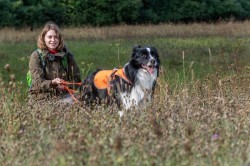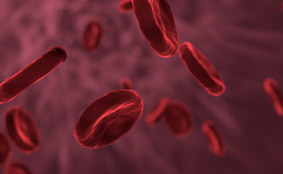Transfer News
July - September 2021
Sniffing for science
 Annegret Grimm-Seyfarth with species tracking dog "Zammy", a Border Collie. Photo: André Künzelmann / UFZ
The lists of the earth's endangered animals and plants are getting longer and longer. But in order to be able to stop this trend, there is always a lack of important information. It is often difficult to find out exactly where individual species still occur and how their populations are developing. Specially trained wildlife tracking dogs can be a valuable help in such cases, a new survey study shows. With the help of the four-legged helpers, the sought-after species can usually be found faster and more effectively than with other methods, report Dr. Annegret Grimm-Seyfarth from the Helmholtz Centre for Environmental Research (UFZ) and her colleagues in the scientific journal Methods in Ecology and Evolution and also offers their services as part of their own company.
Annegret Grimm-Seyfarth with species tracking dog "Zammy", a Border Collie. Photo: André Künzelmann / UFZ
The lists of the earth's endangered animals and plants are getting longer and longer. But in order to be able to stop this trend, there is always a lack of important information. It is often difficult to find out exactly where individual species still occur and how their populations are developing. Specially trained wildlife tracking dogs can be a valuable help in such cases, a new survey study shows. With the help of the four-legged helpers, the sought-after species can usually be found faster and more effectively than with other methods, report Dr. Annegret Grimm-Seyfarth from the Helmholtz Centre for Environmental Research (UFZ) and her colleagues in the scientific journal Methods in Ecology and Evolution and also offers their services as part of their own company.
How many otters are left in Germany? What habitats do the endangered great crested newts use on land? And do hedgehogs which live in big cities have to deal with other problems than their counterparts in the provinces? Anyone who wants to protect the species in question effectively should be able to answer such questions. But this is by no means easy. After all, many animals lead a secretive life in hiding, even their droppings are sometimes difficult to discover. Often, therefore, no one knows exactly whether and at what rate their populations are dwindling or where the last refuges of the survivors are. "We urgently need to know more about these species," says Annegret Grimm-Seyfarth from the UFZ. "But to do that, we first have to find them."
When it comes to mapping open landscapes or detecting larger animals, remote sensing with aerial and satellite imagery can help. For densely overgrown areas and smaller, hidden species, on the other hand, experts traditionally search for them themselves or work with cameras, hair traps and similar tricks. Recently, however, other techniques such as the analysis of tiny DNA traces has been attracting more and more interest worldwide. And it is precisely here that the use of specially trained sniffer dogs can be very useful. After all, a dog's sense of smell is virtually predestined to find the smallest traces of the species it is looking for in nature. While humans have about six million olfactory receptors, a herding dog has access to more than 200 million, a beagle even to 300 million of them. This means that dogs can perceive an extremely large number of different smells, often even in the tiniest concentrations. For example, they can easily find the droppings of animals in a forest or plants, fungi and animals under the ground. At the UFZ, the four-legged helpers have already demonstrated their talents in several research projects.
But biologist Annegret Grimm-Seyfarth went one step further and founded her own company, Monitoring Dogs. Now she and her two tracking dogs Bagheera and Zammy work not only for science, but also for nature conservation or for official detection of various animal species. Together they track down hidden species. They are particularly specialised in otters and amphibians. Soon, the animals are to set out on the trail of invasive plant species in a new project.
Publication:
Annegret Grimm-Seyfarth, Wiebke Harms, Anne Berger: Detection dogs in nature conservation: A database on their worldwide deployment with a review on breeds used and their performance compared to other methods. Methods in Ecology and Evolution (2020), DOI: 10.1111/2041-210X.13560. https://besjournals.onlinelibrary.wiley.com/doi/abs/10.1111/2041-210X.13560
July 2021
Evaluation of algorithms for prediction of unbound fractions in blood
 UFZ scientists have evaluated the most commonly used algorithms for prediction of unbound fractions of pharmaceutical compounds in the human body. Only the free fraction of an absorbed pharmaceutical compound can take a medical effect. The method and the results are described in a recent paper.
UFZ scientists have evaluated the most commonly used algorithms for prediction of unbound fractions of pharmaceutical compounds in the human body. Only the free fraction of an absorbed pharmaceutical compound can take a medical effect. The method and the results are described in a recent paper.
For in vitro in vivo extrapolation of biotransformation data, the different sorptive environments in vitro and in vivo need to be considered. The most common approach for doing so is using the ratio of unbound fractions in vitro and in vivo. In the literature, several algorithms for prediction of these unbound fractions are available.
In this study, UFZ scientists present a theoretical evaluation of the most commonly used algorithms for prediction of unbound fractions in S9 assays and blood and compare prediction results with empirical values from the literature. The results of this analysis prove a good performance of “composition-based” algorithms, i.e. algorithms that represent the inhomogeneous composition of in vitro assay and in vivo system and describe sorption to the individual components (lipids, proteins, water) in the same way. For strongly sorbing chemicals, these algorithms yield constant values for the ratio of unbound fractions in vitro and in vivo. This is mechanistically plausible, because in these cases, the chemicals are mostly bound, and the ratio of unbound fractions is determined by the volume ratio of sorbing components in both phases.
Paper here
July 2021
